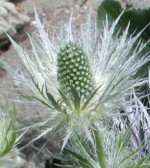 Giant sea holly is a short lived herbaceous perennial often considered a biennial and is native to the Caucasus and Iran. It is a member of the parsley family, Apiaceae, that also includes dill, celery, and Queen Anne’s lace. The first year plants produce a basal rosette of spineless heart-shaped gray-green leaves that is followed in the second year by a flowering stem up to six feet tall with spiny leaves. In summer the small blue gray flowers are carried in closely packed cone-shaped umbels three to four inches long and subtended by eight or nine rigid, toothed silvery bracts. This is large plant and a good choice for the back of the border in a place protected from wind. Although it is short lived it usually self seeds. Plants have a taproot and do not transplant easily. The flower heads add both texture and form to arrangements and are especially beautiful with gray and pink plant material. They can also be preserved for use in winter bouquets. The genus name, Eryngium, is from the Greek word eryngo that refers to the prickly or spiny nature of the genus. The specific epithet, giganteum, is the Latin word meaning unusually tall and refers to the relative height of the plant.
Giant sea holly is a short lived herbaceous perennial often considered a biennial and is native to the Caucasus and Iran. It is a member of the parsley family, Apiaceae, that also includes dill, celery, and Queen Anne’s lace. The first year plants produce a basal rosette of spineless heart-shaped gray-green leaves that is followed in the second year by a flowering stem up to six feet tall with spiny leaves. In summer the small blue gray flowers are carried in closely packed cone-shaped umbels three to four inches long and subtended by eight or nine rigid, toothed silvery bracts. This is large plant and a good choice for the back of the border in a place protected from wind. Although it is short lived it usually self seeds. Plants have a taproot and do not transplant easily. The flower heads add both texture and form to arrangements and are especially beautiful with gray and pink plant material. They can also be preserved for use in winter bouquets. The genus name, Eryngium, is from the Greek word eryngo that refers to the prickly or spiny nature of the genus. The specific epithet, giganteum, is the Latin word meaning unusually tall and refers to the relative height of the plant.
Type:Short-lived perennial or biennial
Bloom:Cone-shaped umbels 3-4″ across of small blue gray flowers subtended y 8 or 9 rigid, toothed silvery bracts, in summer
Size:4-6′ H x 4′ H
Light:Full sun for best color
Soil:Lean, medium moist, well-drained; tolerates drought
Hardiness:�Zones 4-8
Care:Cut stems to the ground after flowering.
Pests and Diseases:None of significance
Propagation:Seed (plants self seed but do not transplant well); division
Companion Plants:Brown eyed Susan, purple coneflower, Russian sage
Outstanding Selections:’Miss. Willmott’s Ghost’